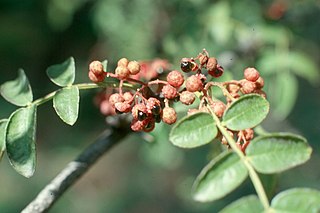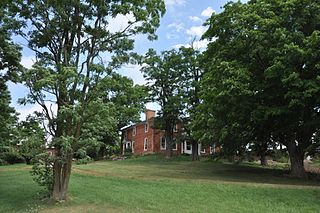Hercules' Club may refer to:

Zanthoxylum is a genus of about 250 species of deciduous and evergreen trees, shrubs and climbers in the family Rutaceae that are native to warm temperate and subtropical areas worldwide. It is the type genus of the tribe Zanthoxyleae in the subfamily Rutoideae. Several of the species have yellow heartwood, to which their generic name alludes. Several species are cultivated for their use as spices, notably including Sichuan pepper.
Prickly ash may refer to:

The prickly shark is one of the two species of sharks in the family Echinorhinidae, found in the Pacific Ocean over continental and insular shelves and slopes, and in submarine canyons. Bottom-dwelling in nature, it generally inhabits cool waters 100–650 m (330–2,130 ft) deep, but it also frequently enters shallower water in areas such as Monterey Bay off California. This stocky, dark-colored shark grows up to 4.0 m (13.1 ft) long, with two small dorsal fins positioned far back on its body and no anal fin. It is characterized by a dense covering of thorn-like dermal denticles, hence its common name.

Zanthoxylum simulans, the Chinese-pepper, Chinese prickly-ash or flatspine prickly-ash, is a flowering plant in the family Rutaceae, native to eastern China and Taiwan. It is one of several species of Zanthoxylum from which Sichuan pepper is produced.
Mazo Beach is the colloquial name for Mazomanie Bottoms State Natural Area, located in Sauk County in the U.S. state of Wisconsin. Property along the river was acquired in parcels by the State of Wisconsin since the 1950s to provide a full range of nature based activities including hiking, wildlife viewing, hunting, fishing, and wildlife habitat. Since 1978, the beach and surrounding nature preserve have attracted picnickers and swimming day-trippers to its open and expansive shoreline.

The prickly dogfish is a poorly known species of dogfish shark in the family Oxynotidae, inhabiting temperate Australian and New Zealand waters. Reaching a length of 75 cm (30 in), this brown to gray shark has a very thick body with a prominent "humpback" and extremely rough skin. It is further characterized by two enormous, sail-like dorsal fins placed relatively close together. Both dorsal fins have a spine embedded mostly within the fleshy leading portion of the fin; the first dorsal spine is tilted forward.

Orites excelsus, commonly known as prickly ash, mountain silky oak or white beefwood, is a species of flowering plant in the family Proteaceae and is endemic to eastern Australia. It is a medium-sized to tall rainforest tree with oblong to lance-shaped leaves, variously lobed and with teeth on the edges. The flowers are white and arranged in leaf axils in spikes that are shorter than the leaves.

Tongchuan is a prefecture-level city located in central Shaanxi province, People's Republic of China on the southern fringe of the Loess Plateau that defines the northern half of the province (Shanbei) and the northern reaches of the Guanzhong Plain.

The term Uzazi refers to the dried fruit of the West African deciduous shrub Zanthoxylum gilletii, syn. Fagara tessmannii, a member of the 'prickly ash' Zanthoxylum genus. The name of the spice is derived from Igbo, a language in Nigeria, where the spice is grown and harvested on a commercial basis. Zanthoxylum gilletii is a close relative of the Sichuan pepper, and uzazi has a similar taste profile to the Asian spice. However, unlike Sichuan pepper where only the pericarp of the fruit is used, uzazi is used whole. This may explain why uzazi has a spicier flavour and greater pungency than sichuan pepper.

Zanthoxylum ailanthoides, also called ailanthus-like prickly ash, is an Asiatic plant of the prickly-ash genus Zanthoxylum, natively occurring in forest-covered parts of southeastern China, Taiwan, Southeast Asia, and Japan from Honshu southward. The piquant fruit serves as a local substitute for the ordinary red-pepper in China before the Columbian exchange. In Taiwan, the young leaves are used in cuisines.
Ash is the solid remains of fire.

Zanthoxylum fagara or wild lime, is a species of flowering plant that—despite its name—is not part of the genus Citrus with real limes and other fruit, but is a close cousin in the larger citrus family, Rutaceae. It is native to southern Florida and Texas in the United States, and to Mexico, Central America, the Caribbean, and South America as far south as Paraguay. Common names include: lime prickly-ash, wild lime, colima, uña de gato, and corriosa.

Zanthoxylum americanum, the common prickly-ash, common pricklyash, common prickly ash or northern prickly-ash, is an aromatic shrub or small tree native to central and eastern portions of the United States and Canada. It is the northernmost New World species in the citrus family, Rutaceae, and is the type species in its genus, which includes sichuan pepper. It can grow to 10 meters (33 ft) tall with a diameter at breast height (DBH) of 15 cm (5.9 in). It produces membranous leaflets and axillary flower clusters. The wood is not commercially valuable, but oil extracts from the bark have been used in traditional and alternative medicine, and have been studied for antifungal and cytotoxic properties. The genus name is sometimes spelled Xanthoxylum.

Opuntia, commonly called the prickly pear cactus, is a genus of flowering plants in the cactus family Cactaceae, many known for their flavorful fruit and showy flowers. Prickly pear alone is more commonly used to refer exclusively to the fruit, but may also be used for the plant itself; in addition, other names given to the plant and its specific parts include tuna (fruit), sabra, nopal from the Nahuatl word nōpalli, nostle (fruit) from the Nahuatl word nōchtli, and paddle cactus. The genus is named for the Ancient Greek city of Opus, where, according to Theophrastus, an edible plant grew and could be propagated by rooting its leaves. The most common culinary species is the Indian fig opuntia (O. ficus-indica).
Toothache tree may refer to one of several American trees:

Mount Royal is situated at the southern end of the Mount Royal Range in the Barrington Tops region of eastern Australia. It is part of the World Heritage Gondwana Rainforests of Australia.
Palo Pinto Mountains State Park is an undeveloped 4,000 plus acre state park in Palo Pinto and Stephens County, Texas near the City of Strawn. The park is located in the Western Cross Timbers Ecoregion. The park is administered by the Texas Parks and Wildlife Department which bought the property from private landowners in October 2011. The park has not received any development money and is not yet open to the public.

The Colonel Ephraim and Sarah Doolittle Farm is a historic farm property on Doolittle Road in Shoreham, Vermont. It is one of the oldest colonial farm properties in western Vermont, established in 1766 by Colonel Ephraim Doolittle, a veteran of the French and Indian War and the American Revolutionary War. It was listed on the National Register of Historic Places in 1995.















